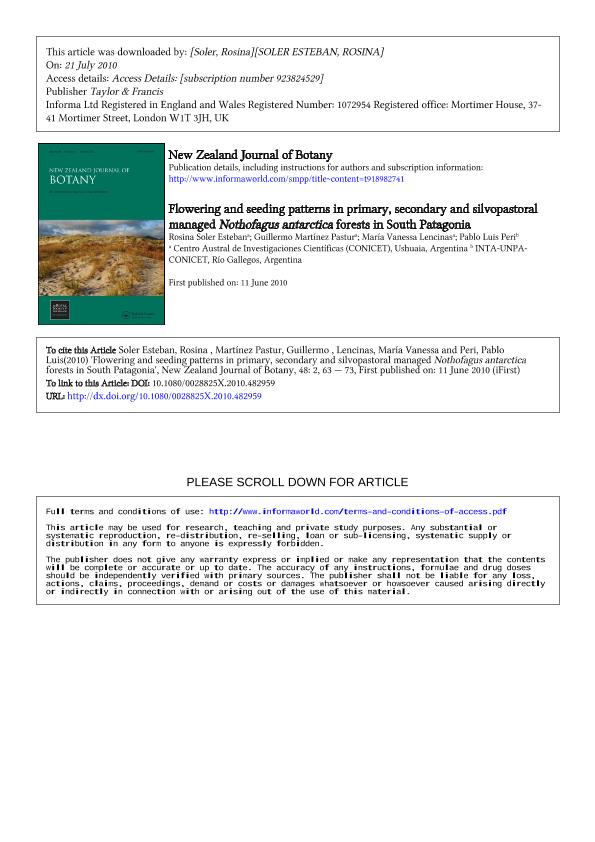Artículo
Flowering and seeding patterns in primary, secondary and silvopastoral managed Nothofagus antarctica forests in South Patagonia
Soler Esteban, Rosina Matilde ; Martínez Pastur, Guillermo José
; Martínez Pastur, Guillermo José ; Lencinas, María Vanessa
; Lencinas, María Vanessa ; Peri, Pablo Luis
; Peri, Pablo Luis
 ; Martínez Pastur, Guillermo José
; Martínez Pastur, Guillermo José ; Lencinas, María Vanessa
; Lencinas, María Vanessa ; Peri, Pablo Luis
; Peri, Pablo Luis
Fecha de publicación:
04/2010
Editorial:
Taylor & Francis
Revista:
New Zealand Journal of Botany
ISSN:
0028-825X
e-ISSN:
1175-8643
Idioma:
Inglés
Tipo de recurso:
Artículo publicado
Clasificación temática:
Resumen
The success of the reproductive process in trees depends on abiotic and biotic factors that determine the final outcome of natural regeneration. Silviculture alters biotic and abiotic factors and results in secondary forest structures. To effectively manage these forests, it is necessary to understand the bottlenecks in reproductive stages using a whole-cycle approach study. The aim of this study was to analyse flowering and seeding patterns in primary, secondary and silvopastoral managed Nothofagus antarctica forests, including investigating the pre-dispersion foraging of insects and birds, as well as abscised biomass production. A high percentage of female flowers produced fruits (95–96%) in which the main loss factor before seeding was the abscission of immature fruits (11–14%). Seeding was greater in secondary forests (11.4 million ha−1), but managed stands presented a higher percentage of flowers resulting in seeds (82%). However, secondary forests had a better seed quality (17% viable seeds), where the main loss factor was empty seeds in all treatments (39–50%). Biotic factors (foraging by insects and birds) were higher in disturbed than primary forests. Nothofagus antarctica produce large quantities of seeds, but abscised immature fruits and empty seeds due to self-incompatibility mechanisms appeared as the major loss factors.
Archivos asociados
Licencia
Identificadores
Colecciones
Articulos(CADIC)
Articulos de CENTRO AUSTRAL DE INVESTIGACIONES CIENTIFICAS
Articulos de CENTRO AUSTRAL DE INVESTIGACIONES CIENTIFICAS
Articulos(SEDE CENTRAL)
Articulos de SEDE CENTRAL
Articulos de SEDE CENTRAL
Citación
Soler Esteban, Rosina Matilde; Martínez Pastur, Guillermo José; Lencinas, María Vanessa; Peri, Pablo Luis; Flowering and seeding patterns in primary, secondary and silvopastoral managed Nothofagus antarctica forests in South Patagonia; Taylor & Francis; New Zealand Journal of Botany; 48; 2; 4-2010; 63-73
Compartir



